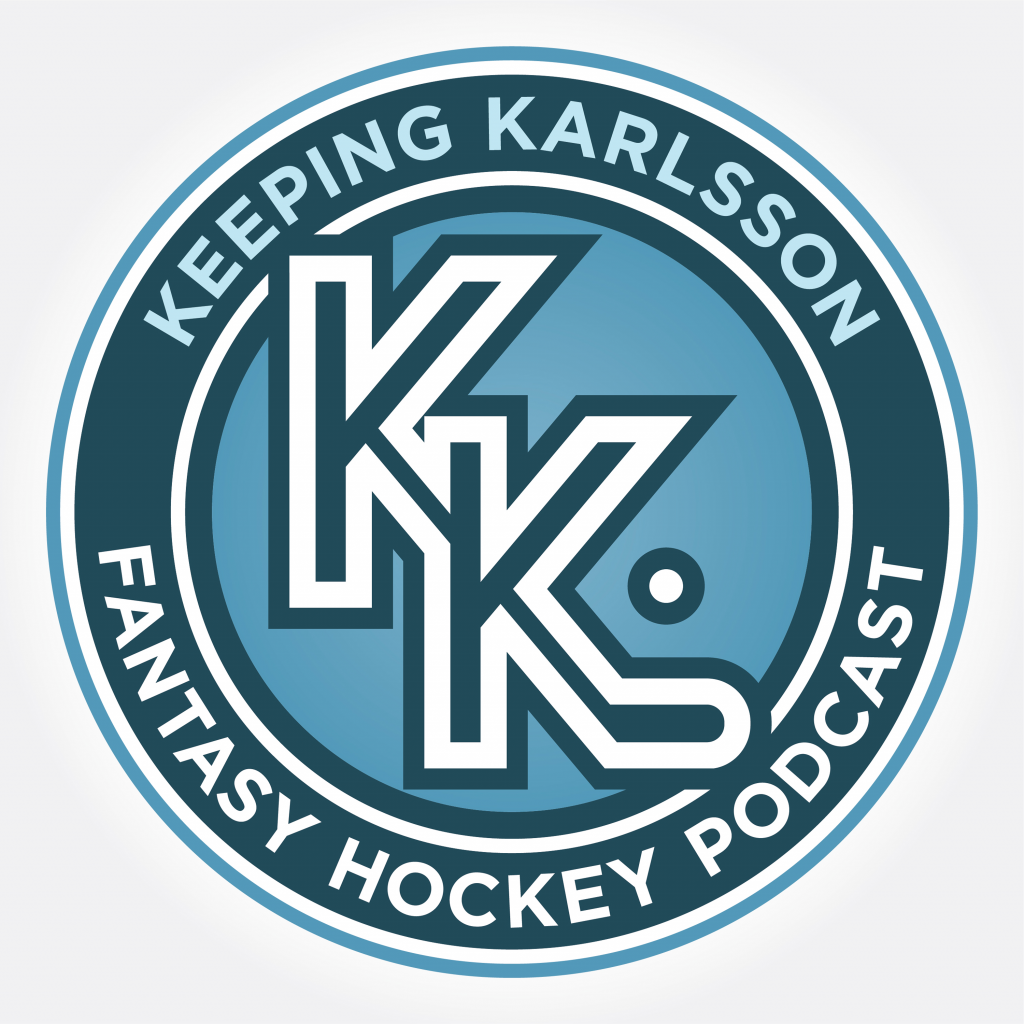After nearly three years without being able to play in an NHL game, Colorado Avalanche winger, and captain, Gabriel Landeskog made his return to the lineup. It has been an extensive recovery from his knee cartilage transplant surgery but he has made it all the way back in one of the best stories of the season.
*
Also returning to the lineup after an extended absence was Edmonton Oilers forward Evander Kane. He missed the entire 2024-25 regular season with hip, abdomen, hernia, and knee surgeries. He took the place of Jeff Skinner, who was healthy scratched after playing his first-ever playoff game.
*
It was another game featuring excellent goaltending at both ends, but a game in which the Washington Capitals were able to, er, capitalize on an extra scoring chance and win 3-1 at home to Montreal. That win gives the Capitals a 2-0 series lead as they hold serve at home with Game 3 set for Friday night in Montreal.
Connor McMichael and Dylan Strome scored a minute apart early in the second period with the latter's tally holding up as the game-winner. McMichael added an empty netter with two seconds left on the clock to seal the game. He finished the game with those two goals on four shots and a block.
Anthony Beauvillier assisted the Strome goal while adding three shots, two blocks, and three hits in a very good multi-cat fantasy effort. That gives Beauvillier three points, eight shots, and seven hits in the two games in Washington.
Logan Thompson was excellent in goal, especially in the third period, stopping 25 of 26 shots overall for the win.
Christian Dvorak scored Montreal's lone goal. It was assisted by Josh Anderson who had two shots, six PIMs, and six hits in the game.
Sam Montembeault kept Montreal in the game all night long but took the loss, allowing two goals on 31 shots.
*
In a similar path to Game 2, the Dallas Stars tied Game 3 halfway through the third period, this time on a power-play goal from Jamie Benn, before taking the win in overtime, this time thanks to Tyler Seguin. The thrilling 2-1 victory lifted Dallas to a 2-1 series lead, a lead I'm sure many people did not think they would have once word came down that not only would Miro Hiskanen start the series out of the lineup, but Jason Robertson, too.
Mikko Rantanen had his best game of the postseason thus far with an assist on the OT winner, five shots, three blocks, two PIMs, and a hit. The Stars also outshot the Avalanche 11-4 with him on the ice.
Thomas Harley also had an assist (PP) with two blocks and a hit in nearly 30 minutes of ice time. He has been on the ice for nearly 46% of the series thus far.
Jake Oettinger also had his best game of the series thus far, stopping 27 of 28 shots to help his team to the series lead.
Valeri Nichushkin scored the lone Colorado goal. Sam Malinski, reinserted into the lineup, assisted on that goal and added both a block and a hit in 12:23 of overtime.
Mackenzie Blackwood was solid but gave up two goals on 28 shots to take the loss.
Colorado went 0/6 on the power play, including a four-minute PP at the end of the third period/start of overtime.
*
Though it didn't have quite the dramatics of Game 1, Game 2 saw Los Angeles get out to a 3-0 lead over Edmonton before a late second-period goal from Leon Draisaitl and early third-period goal from Viktor Arvidsson to make it 3-2. However, that's as close as they would get as the Kings scored three goals in under 4:30 of game time to skate away with a 6-2 win and 2-0 series lead.
After an excellent Game 1, Los Angeles' top line was tremendous again in Game 2: Adrian Kempe had two goals, two assists (both PP), eight shots, two PIMs, and three hits; Anze Kopitar had a goal (PP), three assists (one PP), a block, and a hit; Andrei Kuzmenko scored once (PP), added a late assist, totaled four shots, and managed a hit. That makes six goals and 17 points combined for the top line through two games. It has been a decent start.
Quinton Byfield also scored second in as many games while totaling three shots, two blocks, two PIMs, and four hits. Dating back three months, Byfield has 16 goals, 20 assists, 80 shots, 47 hits, and 21 blocks in his last 37 games. This is the player many of us hoped he would be.
Brandt Clarke got the ball rolling with his first career NHL postseason goal (PP).
Darcy Kuemper held down the fort, turning away 24 of the 26 shots he faced.
Stuart Skinner was pulled after Los Angeles' fifth goal, their 28th shot of the night. Calvin Pickard came in on relief duty and gave up one goal on three shots.
Game 3 goes Friday night in Edmonton.
*
In these Ramblings on Tuesday, we started a review of preseason projections and what went right or wrong. Those Ramblings covered forwards with goal totals who came in far below what I had projected for them. Today, we'll stay with the forwards but cover those who came in with far more goals than I projected. We will be using end-of-year data from Natural Stat Trick, limit it to forwards with at least 41 games played and those projected for at least 10 goals scored.
Here are the forwards who scored at least 50% more goals than I had projected. For example, if someone was projected for 10 goals, their 82-game pace was for at least 15. If they were projected for 20 goals, their pace was for at least 30, and so on:
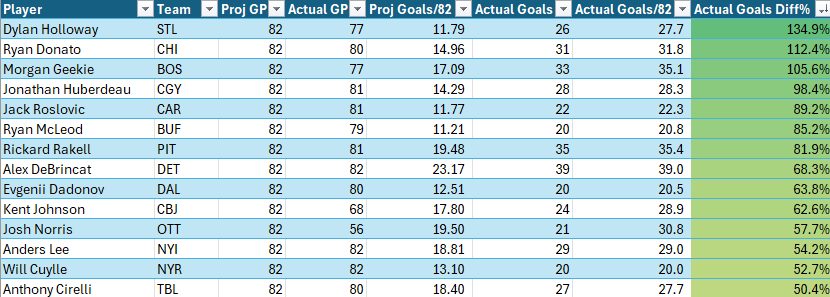
We should review some of the notable ones here.
Dylan Holloway (St. Louis Blues)
For people who believed that Holloway would be a top-6 forward in the league, this may not have been a huge surprise. All the same, this is a player who nearly doubled his points per 60 minutes at 5-on-5 in 2024-25 (2.32/60) compared to his first two seasons (1.17/60). By some full-season measures at Evolving Hockey, Holloway didn't just have a breakout year with 26 goals and 37 assists in 77 games, but was a top-30 skater in the league (and probably even higher).
It isn't a mirage, either. His play-driving numbers improved, his tracking data from AllThreeZones improved, and his shooting percentage (14.6%) wasn't far off the league average from regular forwards (13.1%). For him to take the next leap in fantasy value, he needs a lot more power-play production after posting just 13 PP points this season, but if he plays like this again in 2025-25, he has 30-goal, point-per-game upside.
Morgan Geekie (Boston Bruins)
Geekie scored 33 goals in 77 games, which is pretty surreal considering he scored 39 goals in his prior 256 games. It really helps to play with David Pastrnak, though: Pastrňák assisted on 21 of Geekie's 33 goals, and had the primary assist on 16 of them. This is a guy who had a career shooting percentage of 11.4%, had a career-high of 13.1% in 2023-24, and finished second in the league by even-strength shooting percentage (21.97%). It is hard to bank on Geekie repeating that next season, but a bit more ice time overall with consistent top PP minutes all season will help soften the shooting percentage regression. With this role and Pastrňák as a consistent line mate, Geekie is a 25-goal guy.
Jonathan Huberdeau (Calgary Flames)
Huberdeau finished the season with 13 goals at 5-on-5 after having scored just 17 in his first two years with Calgary. He did that by shooting 13.3%, a big improvement on the 8.95% he shot in the prior two campaigns with the Flames. It wasn't just luck, either, as he got way more shots off high-danger passes from his teammates than he was getting previously (again from AllThreeZones):

Of course, the big improvement came on the power play where he scored 10 goals after scoring just eight the prior two seasons. He did that by shooting 26.3% on the PP, a career-high (he had never exceeded 20% prior to 2024-25). It was a great year from Huberdeau, and maybe his even strength scoring stays higher than where it was from 2022-2024, but it'll be hard to replicate that kind of power-play success.
Rickard Rakell (Pittsburgh Penguins)
Rakell shot 17% in 2024-25 after never exceeding 11.5% in any of his seasons with Pittsburgh and averaging 10.3% with the Penguins. He also added 2:47 per game in ice time. Unlike Huberdeau, there wasn't a big increase in those shots off high-danger passes (it actually declined on a per-minute basis when compared to 2023-24). This is a big miss, but not one I will sleep over.
Alex DeBrincat (Detroit Red Wings)
At 5-on-5 in 2024-25, DeBrincat had:
- 9.01 shots per 60 minutes, his highest mark in any season where he's played more than 70 games.
- 0.88 individual expected goals/60, his highest mark in any season
- 12.8% shooting, his highest mark in any season with over 70 games since 2018-19
- 1.15 goals/60, his highest mark in any season with over 70 games since 2018-19
Even crazier is that in his 747 minutes at 5-on-5 playing without Dylan Larkin, DeBrincat scored nearly 48% of Detroit's goals. This season will require more digging because if you told me back in September that DeBrincat would score 39 goals, I wouldn't be surprised. If you told me he scored 39 goals and only skated about one-third of his 5-on-5 time with Larkin as his centre, I would have been very surprised.
Kent Johnson (Columbus Blue Jackets)
While the Jackets are a team I was high in the preseason on for fantasy purposes (mainly due to low ADPs), Johnson was not a player on my radar. I had him no higher than fourth on the winger depth chart behind Kirill Marchenko, Dmitri Voronkov, and Yegor Chinakhov. That had him closer to about 15:30 per game in TOI in my projections compared to the 17:18 he actually earned, or a full 3:45 more per game than in 2023-24.
Johnson's goal-scoring success wasn't just due to more ice time or the power play, though, as he scored 19 goals at 5-on-5 in 68 games after scoring just 14 in his prior 130 career games – shooting over 20% at 5-on-5 helps a lot. There wasn't a high-danger shot increase like with Huberdeau or an expected goal increase like DeBrincat (at least not on a per-shot basis). It is also one of those things that as I think back to watching Johnson play this season, his offensive skill often stood out nearly every time. With 80 games and a bit more ice time next season, it isn't hard imagining him scoring 25 goals.
Will Cuylle (New York Rangers)
Lost in all the bad news/bad performance in and around the Rangers this season was a great year from Cuylle with 20 goals, 25 assists, 152 shots, 301 hits, and 50 blocks. He is the only player since the NHL started tracking hits and blocks in 2007 to post a season with at least 20 goals, 25 assists, 150 shots, 300 hits, and 50 blocks (Brady Tkachuk wasn't far off in 2019-20). While a big part of his 5-on-5 production was 11 secondary assists, he did average 1.0 expected goals per 60 minutes, making him 1 of 19 forwards to reach that mark (minimum of 700 minutes played).
We will hold off on more analysis of what it means moving forward until we see what the Rangers do this summer because it seems very likely the lineup undergoes more changes. All the same, Cuylle had as many goals from tips or deflections (6) as Chris Kreider in just 97 more minutes played with minimal power-play time. They very well may have found their next Kreider.

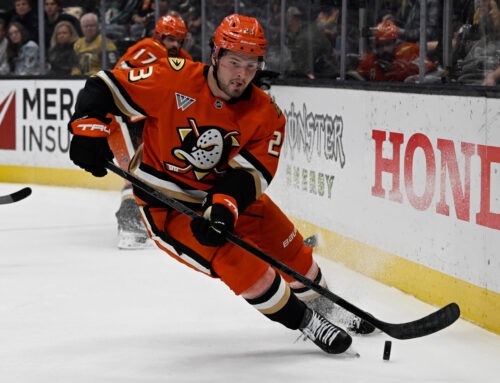
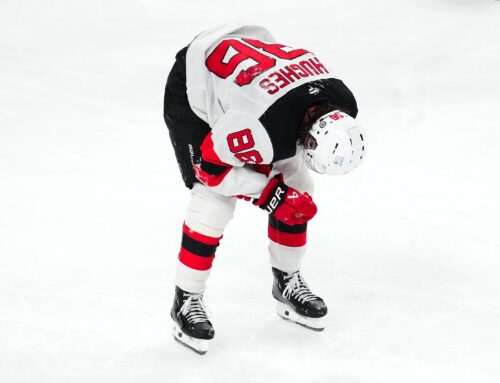
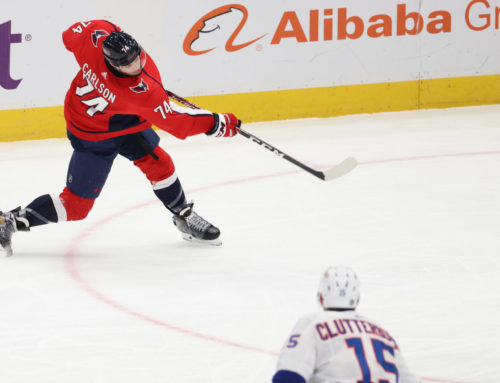
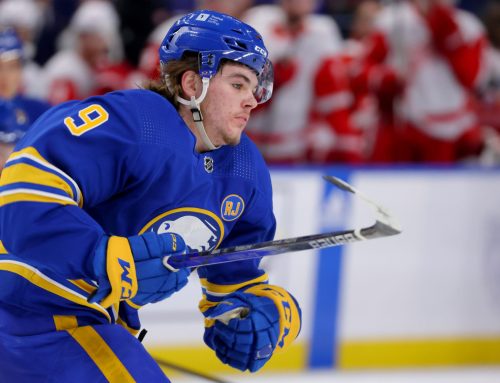
 MTL
MTL
 PIT
PIT FLA
FLA S.J
S.J MIN
MIN CGY
CGY L.A
L.A
